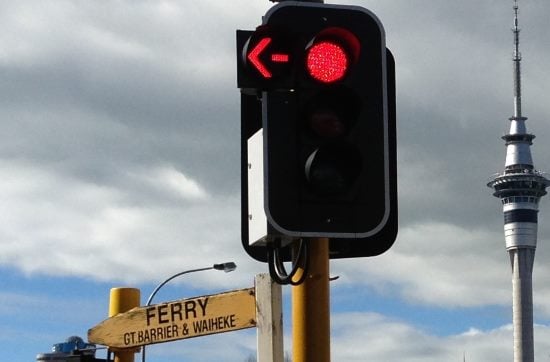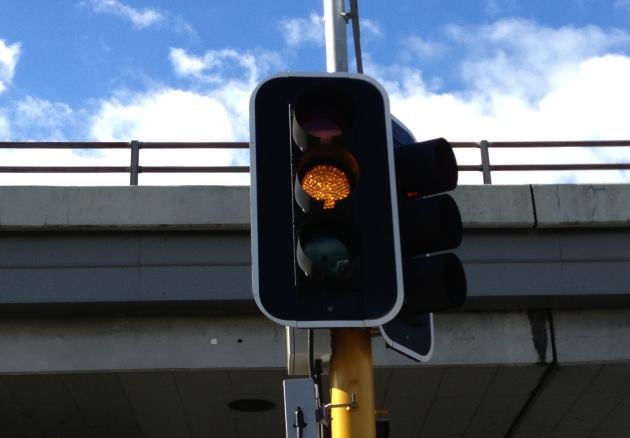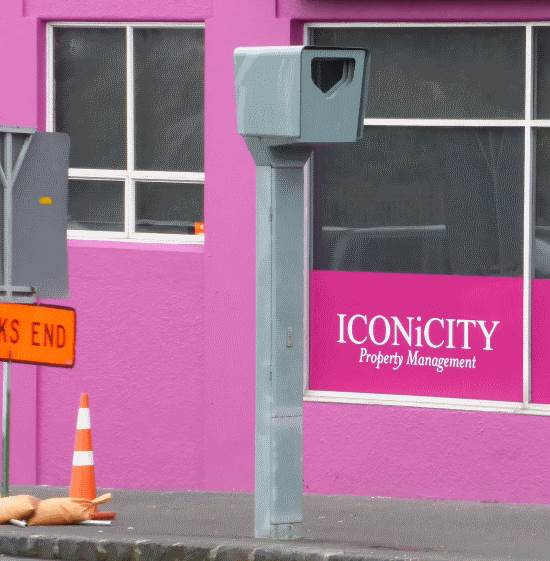A. Buses, taxis and bicycles can park here
 What do these lights mean?
What do these lights mean?
A. Buses, taxis and bicycles can park here
B. When lit, buses, trams and bicycles can pass through, ignoring a red traffic signal
C. This is a special lane on a road or motorway for buses, trams and bicycles
D. When lit, buses, trams and bicycles must wait for other traffic to pass before proceeding
Our traffic lights conform to international standards in terms of their colour, but we have slightly different phasing than some countries.
A red light always means stop. You must wait until the green light shows before you can proceed. A police officer's directions can overrule a red light. There is not a free left turn.
A green light means you can go, as long as it's safe to do so.
 Filter lights are arrows that point left, right or straight ahead. They give specific directions to the traffic and can be used when traffic needs to be held to allow pedestrians to cross, or in complex junctions where one or more lanes can be allowed to proceed independently of others.
Filter lights are arrows that point left, right or straight ahead. They give specific directions to the traffic and can be used when traffic needs to be held to allow pedestrians to cross, or in complex junctions where one or more lanes can be allowed to proceed independently of others.
Intersections which are busy, have fast-moving traffic, have two or more lanes in either direction or have restricted visibility are more likely to have a red turning arrow to prevent drivers from making ill-judged decisions. It also allows for right-turning traffic to definitely turn and, with the use of sensors in the road, means that the turn signal only needs to be activated when there are vehicles waiting if there is a dedicated right-turn lane or bay.
For example, in the traffic signal shown to the left, traffic can go straight ahead but must wait to turn left. This combination is often seen where pedestrians are crossing to the left.
 This image shows a green filter light to the left. This is most frequently seen where two sets of facing traffic want to turn to the right. Both directions can turn right without interfering with each other's trajectories.
This image shows a green filter light to the left. This is most frequently seen where two sets of facing traffic want to turn to the right. Both directions can turn right without interfering with each other's trajectories.
The image below shows a red filter light and red light ahead.

This amber or yellow traffic light comes after a green light and indicates that the lights are just about to turn red. You should stop if it's safe to do so, and this will vary according to the road conditions, the braking ability of your car, and the ability for people behind you to stop.
If a traffic light is faulty it will flash yellow and you should apply the give way rules.
The basic give way rules are:

Buses, cycles and trams can be given permission to go first using one of the above priority lights when they are travelling in their own lane.
The length of time that the yellow light displays depends on the speed of the intersection. A typical yellow light in an urban area lasts for approximately four seconds. We timed several downtown Auckland lights to come up with an average of 3.8 seconds. In the UK, yellow lights are 1 second per 10mph (16kph) speed limit. Using the same logic the equation would be 1 second every 13.2kph at least for the amber lights we measured.
Yellow traffic lights on faster streets may stay on longer because it takes longer for vehicles to stop.

The traffic signal phase in New Zealand goes red, green, yellow, red. Some countries have a combined yellow+green phase or a rapidly flashing amber which can indicate that you can go on a pedestrian crossing as long as all pedestrians have finished crossing.
Red and green traffic lights have variable phases, depending on the intersection. More roads joining the intersection will mean a longer red phase. A minor road entering a major intersection could have a very short green phase because there might only ever be one or two vehicles waiting at any one time, whereas a large intersection with a main road travelling through it could see very long green phases on the main road.
Phases can be altered by detecting vehicles at an intersection using a magnetic induction loop in the road. Newer systems use cameras and are monitored by an operations centre.
Going through the red light is called red light running and is a cause of accidents. Running the red light is dangerous.
Pedestrians could start to cross and you risk hitting them - bear in mind pedestrians on the other side of the junction will be further across the crossing and therefore less likely to be able to avoid you
Vehicles may start to move, especially ones which are obscured from your view
Road users run red lights sometimes deliberately, and sometimes accidentally:
Traffic signals are installed and operated so that when everyone obeys the rule traffic flows more smoothly.
The yellow light that precedes the red light displays for around 3.8-4 seconds in urban areas therefore you have plenty of time to stop before the intersection if you are not in a position where you would have passed through the intersection completely should you hold your speed steady.
Not stopping at a red light is an offence and if you are caught you will be fined.
Some intersections are covered by a red light camera such as the one pictured below. They use sensors in the road to detect if a vehicle proceeds beyond the give way or stop line after the light has turned red. If you are already in the intersection when the lights turn red, then you won't trigger the camera.
